import numpy as np
import matplotlib.pyplot as pltdef rgb_to_gray(rgb):
r, g, b = rgb[:, :, 0], rgb[:, :, 1], rgb[:, :, 2]
gray = 0.2989 * r + 0.5870 * g + 0.1140 * b
return grayPlotting grayscale image
todo;
- choose the right two images to be used
- plot two images sidewise
- create amp and phase image for both images and plot them
- create image by combining amp of first image and phase of second image and plot it
duck = "duck.jpg"
pattern = "pattern.jpg"Images
duck_img = rgb_to_gray(plt.imread(duck))
pattern_img = rgb_to_gray(plt.imread(pattern))plt.subplots(figsize=(16, 8))
plt.subplot(1, 2, 1)
img = plt.imshow(duck_img)
img.set_cmap('gray')
plt.subplot(1, 2, 2)
img = plt.imshow(pattern_img)
img.set_cmap('gray')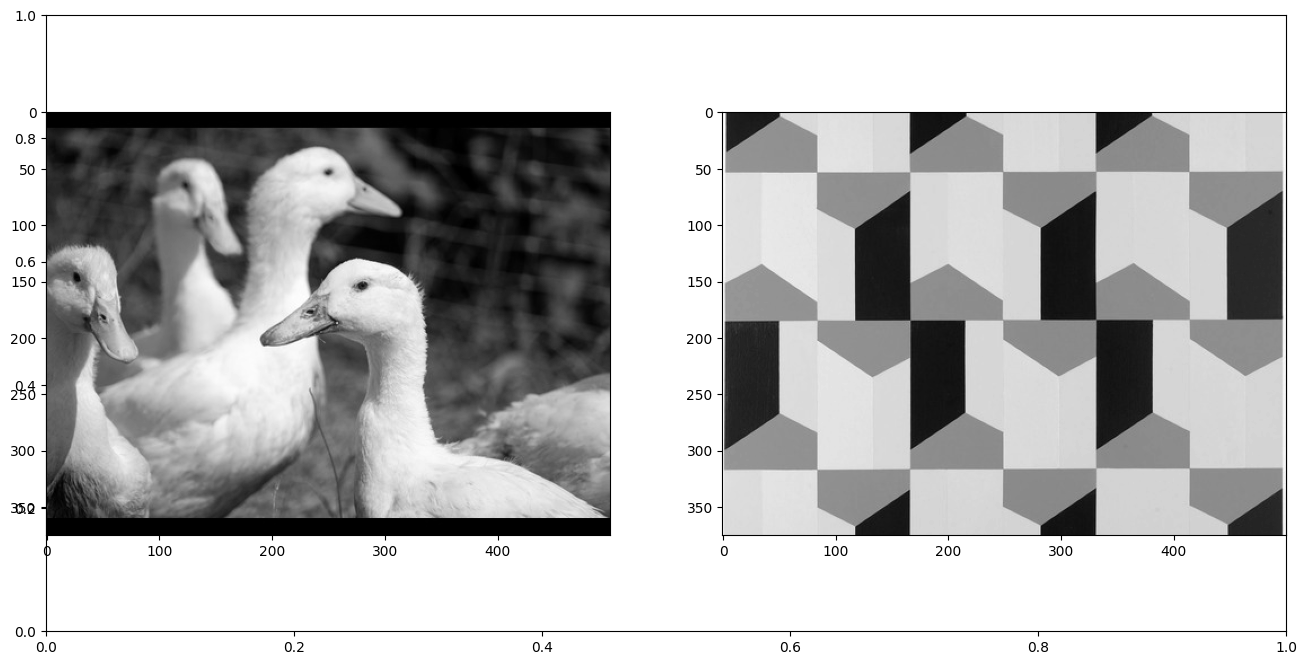
Apply fourier transformation on duck image
# duck_fft = np.fft.fft2(np.fft.fftshift(duck_img))
duck_fft = np.fft.fftshift(np.fft.fft2(duck_img))
plt.subplots(figsize=(12, 5))
plt.suptitle("Amp and Phase image for duck")
plt.subplot(1, 2, 1)
plt.imshow(10. * np.log10(np.abs(duck_fft)))
plt.subplot(1, 2, 2)
plt.imshow(np.angle(duck_fft))<matplotlib.image.AxesImage at 0x7f2c2dda87c0>
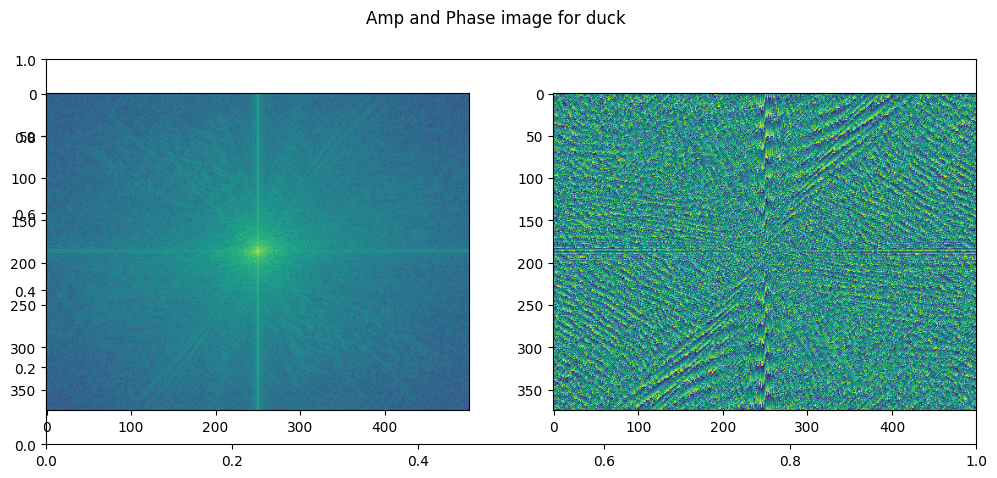
Apply fourier transformation on pattern image
pattern_fft = np.fft.fftshift(np.fft.fft2(pattern_img))
plt.subplots(figsize=(12, 5))
plt.suptitle("Amp and Phase image for pattern")
plt.subplot(1, 2, 1)
plt.imshow(10. * np.log10(np.abs(pattern_fft)))
plt.subplot(1, 2, 2)
plt.imshow(np.angle(pattern_fft))<matplotlib.image.AxesImage at 0x7f2c300e8670>
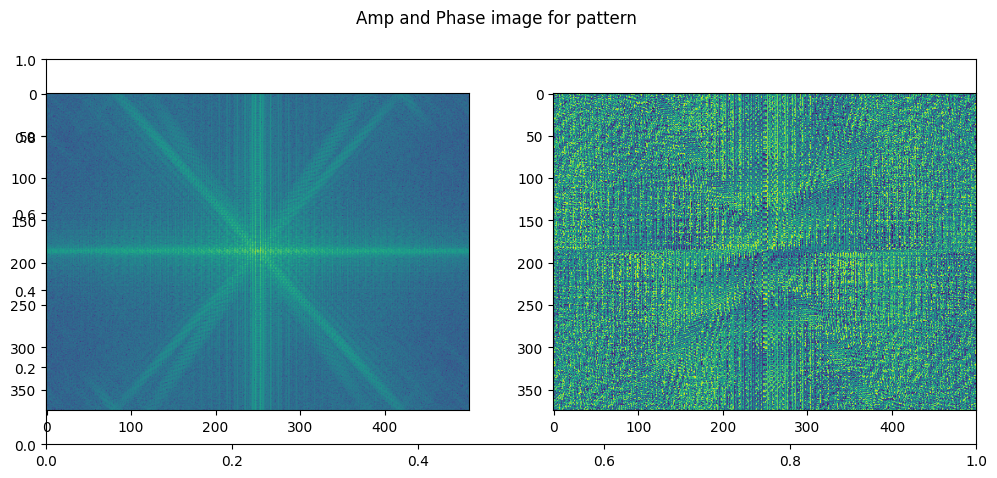
Create image using amp of pattern and phase of duck
amp = np.abs(pattern_fft)
phase = np.angle(duck_fft)
hybrid_ftt = amp * (np.cos(phase) + 1j * np.sin(phase))
# applying inverse fft
hybrid = np.abs(np.fft.ifft2(np.fft.fftshift(hybrid_ftt)))
plt.figure(figsize=(8, 8))
plt.title("Image created with amp of pattern and phase of duck image")
img = plt.imshow(hybrid)
img.set_cmap('gray')
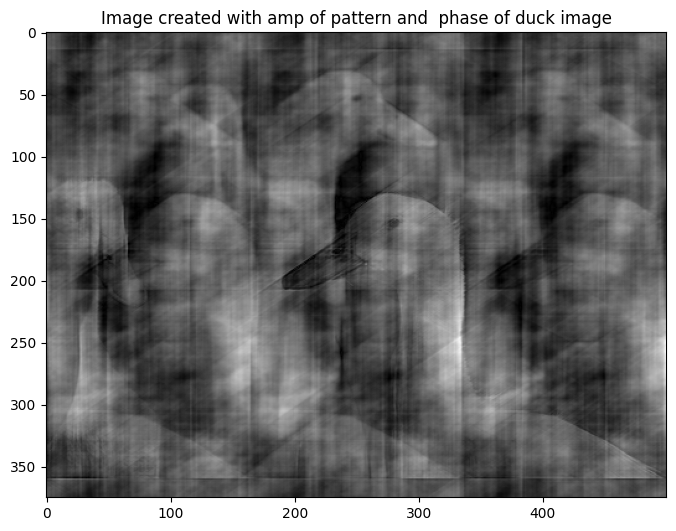
Create image using amp of duck and phase of pattern
amp = np.abs(duck_fft)
phase = np.angle(pattern_fft)
hybrid_fft = amp * (np.cos(phase) + 1j * np.sin(phase))
hybrid = np.abs(np.fft.ifft2(np.fft.fftshift(hybrid_fft)))
plt.figure(figsize=(8, 8))
plt.title("Image created with amp of duck and phase of pattern")
img = plt.imshow(hybrid)
img.set_cmap("gray")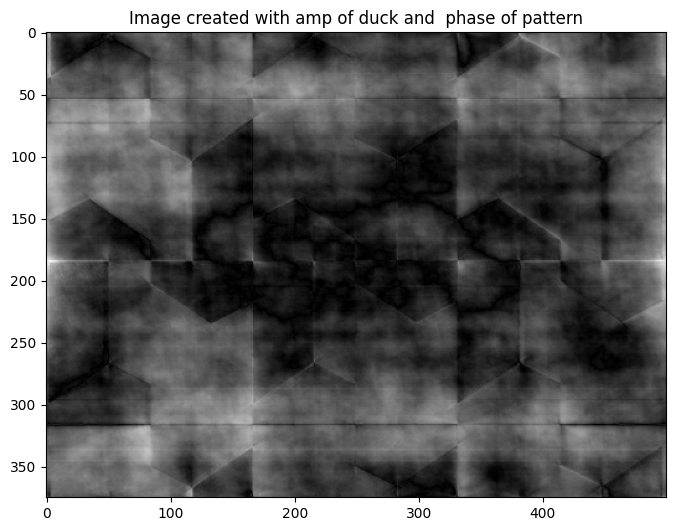
Remarks
- Phase mostly defines the structures of the image. So, when phase of duck is used and amp of pattern, only the duck is visible.
- When phase of pattern and amp of duck is used, we can only see the pattern.
Creating duck image using its phase and amp of all values 1.
phase = np.angle(duck_fft)
amp = np.ones_like(duck_fft)
phase_only_duck_fft = amp * (np.cos(phase) + 1j * np.sin(phase))
phase_only_duck = np.abs(np.fft.ifft2(np.fft.fftshift(phase_only_duck_fft)))
plt.figure(figsize=(8, 8))
plt.title("Duck phase only")
img = plt.imshow(phase_only_duck)
img.set_cmap("gray")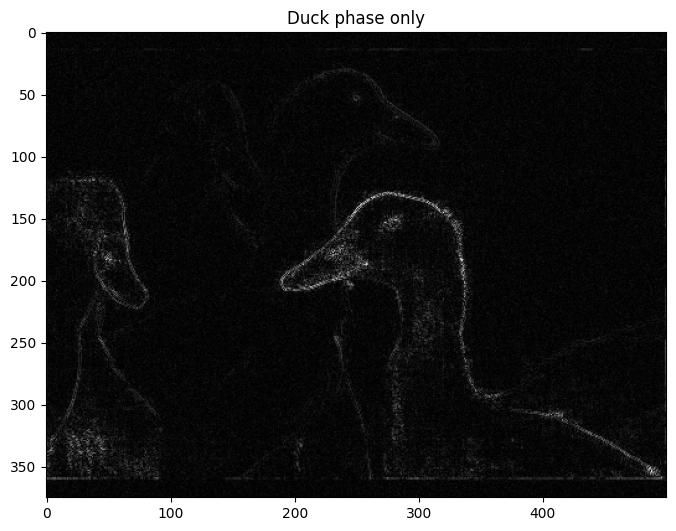
Creating duck image using amp only
amp = np.abs(duck_fft)
phase = np.angle(np.zeros_like(duck_fft))
amp_only_duck_fft = amp * (np.cos(phase) + 1j * np.sin(phase))
amp_only_duck = np.abs(np.fft.ifft2(np.fft.fftshift(amp_only_duck_fft)))
plt.subplots(figsize=(16, 8))
plt.suptitle("Duck image using amp only")
plt.subplot(1, 2, 1)
plt.title("Duck image")
img = plt.imshow(amp_only_duck)
img.set_cmap("gray")
# using decibles
amp = 10. * np.log10(np.abs(duck_fft))
amp_only_duck_fft = amp
plt.suptitle("Duck image using amp in dB")
plt.subplot(1, 2, 2)
img = plt.imshow(amp)
img.set_cmap("gray")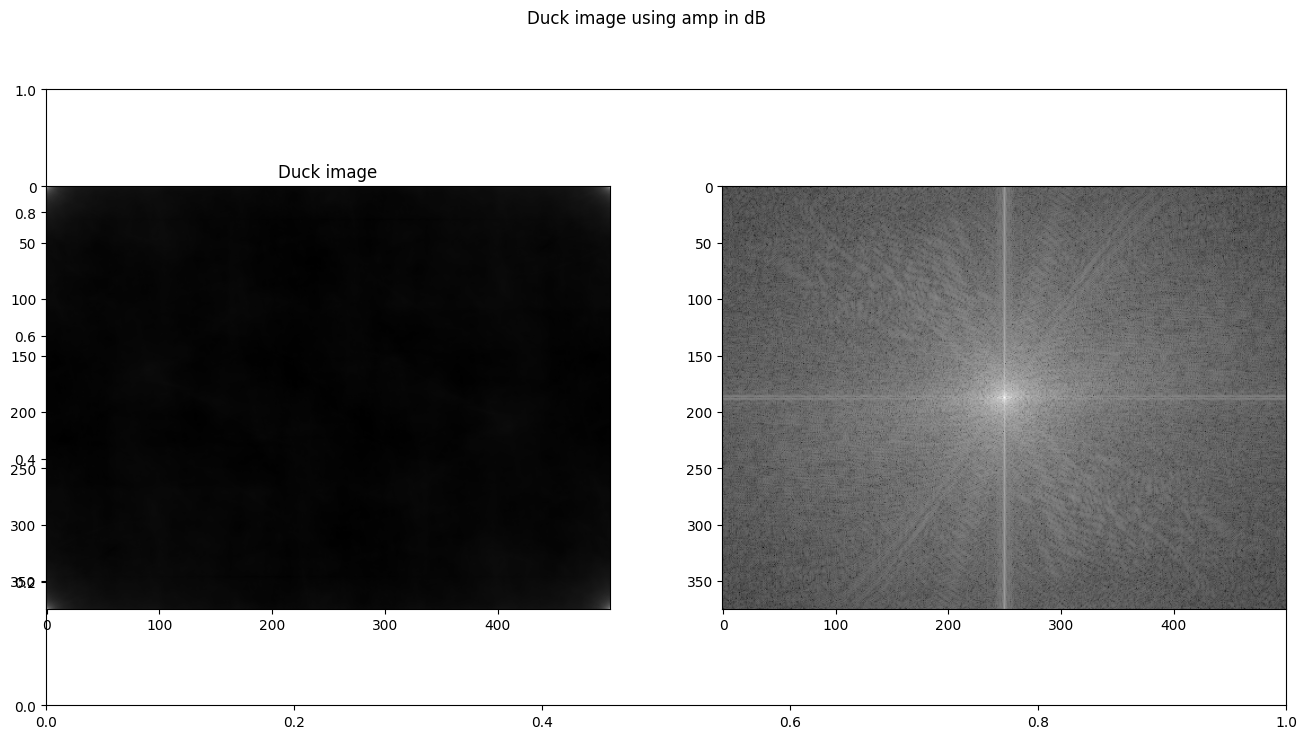
Creating duck images using real and imaginary components
duck_fft_real = duck_fft.real
duck_fft_imag = duck_fft.imag
duck_real = np.abs(np.fft.ifft2(duck_fft_real))
duck_imag = np.abs(np.fft.ifft2(duck_fft_imag))
plt.subplots(figsize=(12, 4.5))
plt.suptitle("Duck images using real and imaginary parts")
plt.axis("off")
plt.grid(False)
plt.subplot(1, 2, 1)
img = plt.imshow(duck_real)
img.set_cmap("gray")
plt.subplot(1, 2, 2)
img = plt.imshow(duck_imag)
img.set_cmap("gray")
Plotting point source image
def point_source_fft(img_size, y_pos, x_pos, amp=1):
point_img = np.zeros((img_size + 1, img_size + 1))
point_img[y_pos, x_pos] = amp
plt.subplots(figsize=(18, 8))
plt.suptitle("Single point image")
plt.grid(False)
plt.axis(False)
plt.subplot(1, 2, 1)
plt.title("Single centered point image")
plt.imshow(point_img, interpolation='nearest')
plt.colorbar(shrink=0.8)
plt.set_cmap("gray")
## not sure why fftshit is happening before fourier transformation here?? above images shows opposite of it.
point_img_fft = np.fft.fft2(np.fft.fftshift(point_img))
# point_img_fft = np.fft.fftshift(np.fft.fft2(point_img))
phase = np.angle(point_img_fft)
plt.subplot(1, 2, 2)
plt.title("Phase")
plt.imshow(phase)
plt.colorbar(shrink=0.8)
plt.set_cmap('hsv')img_size = 128
x_pos = (img_size // 2) + 1
y_pos = (img_size // 2) + 1
point_source_fft(img_size, y_pos, x_pos)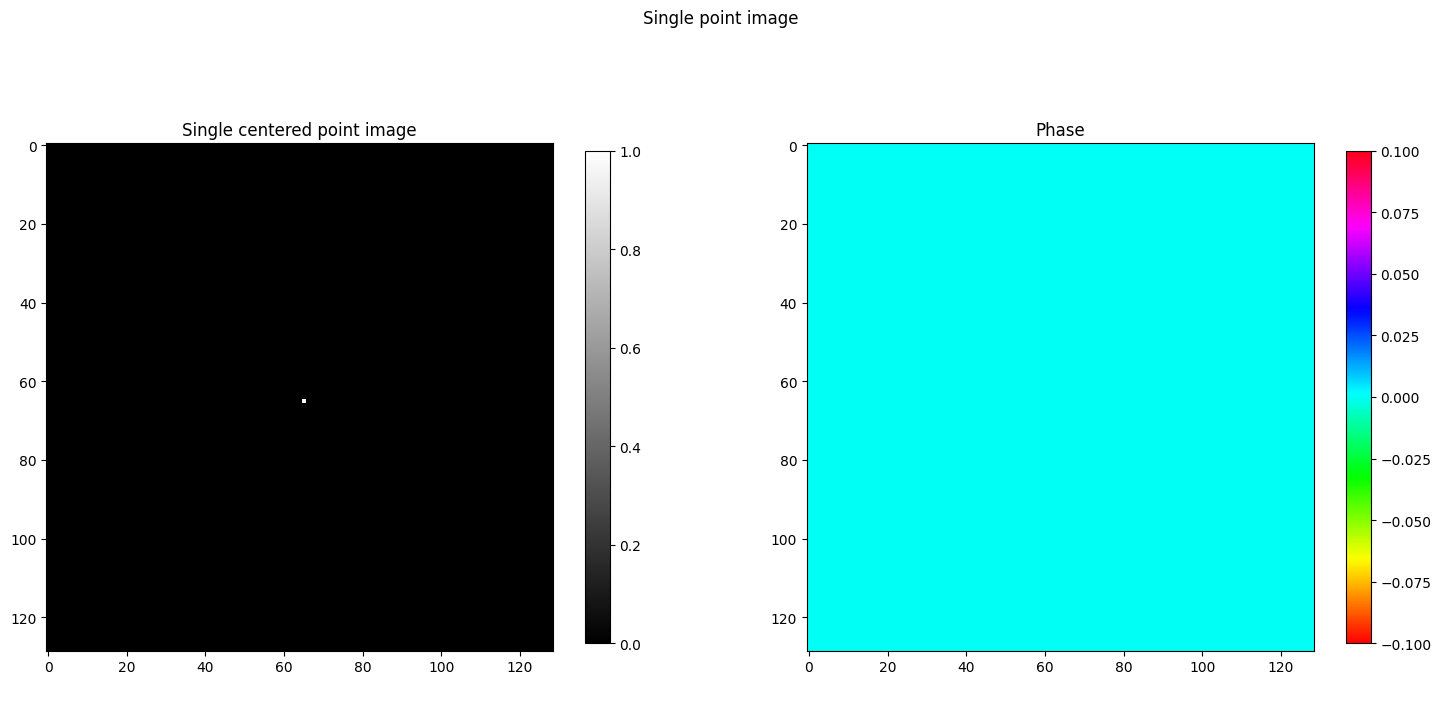
Phase fringe patterns on point location change from center
img_size = 128
point_source_fft(img_size, (img_size // 2) + 1, (img_size // 2))
point_source_fft(img_size, (img_size // 2) + 1, (img_size // 2) + 1 - 10)
point_source_fft(img_size, (img_size // 2) + 1 - 10, (img_size // 2) + 1)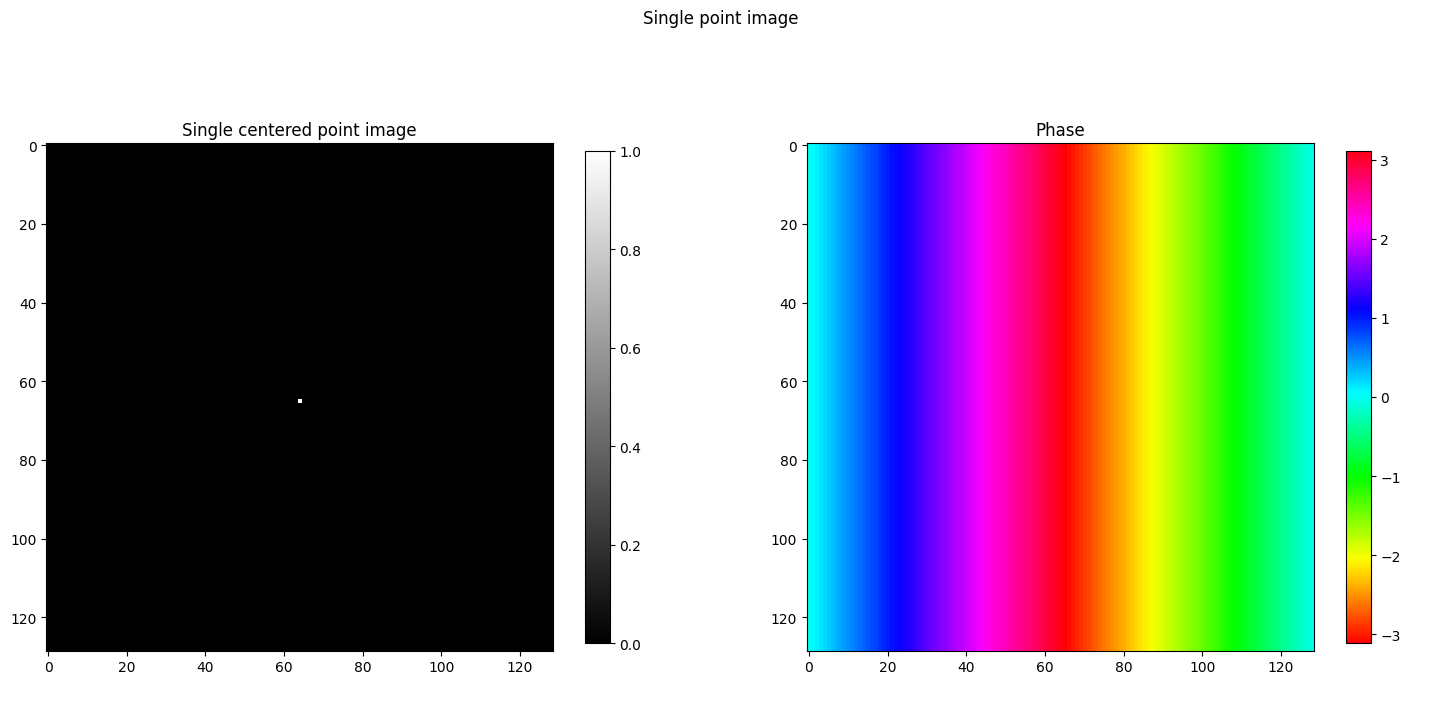
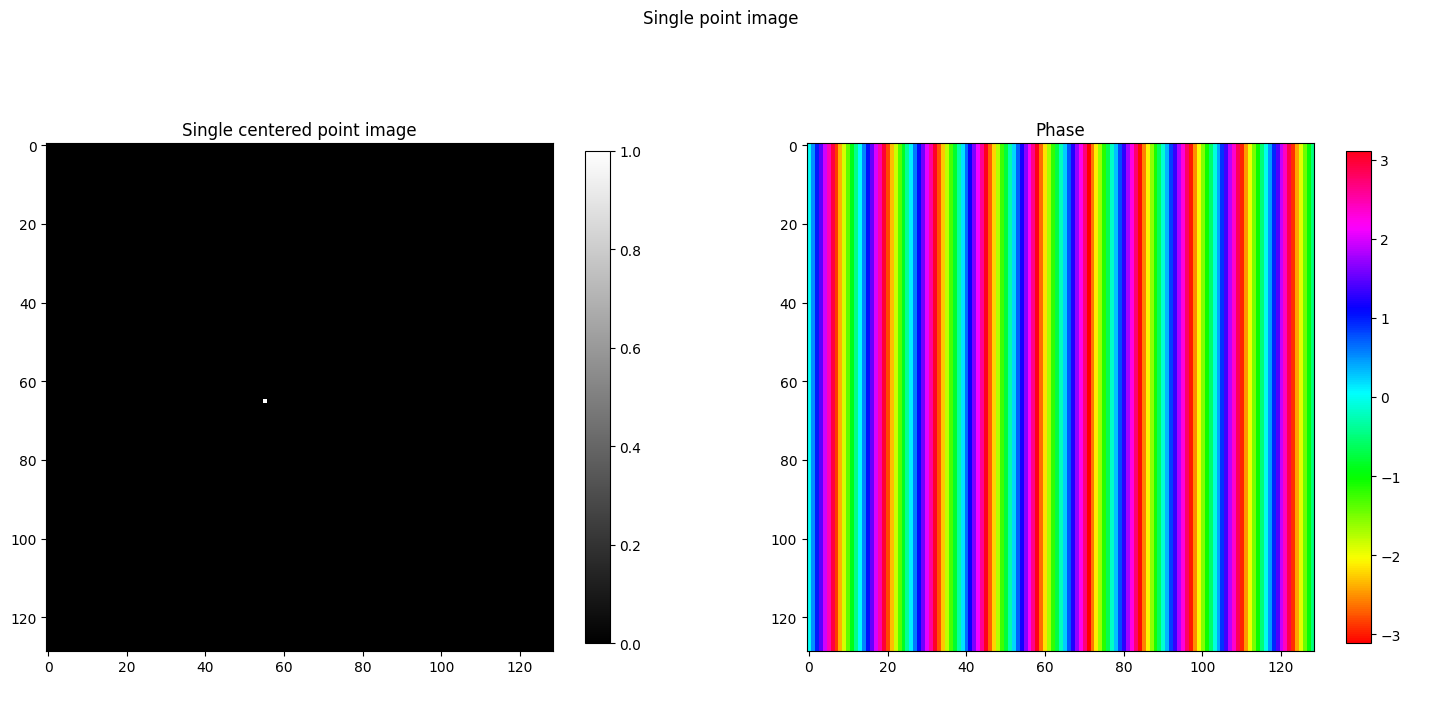
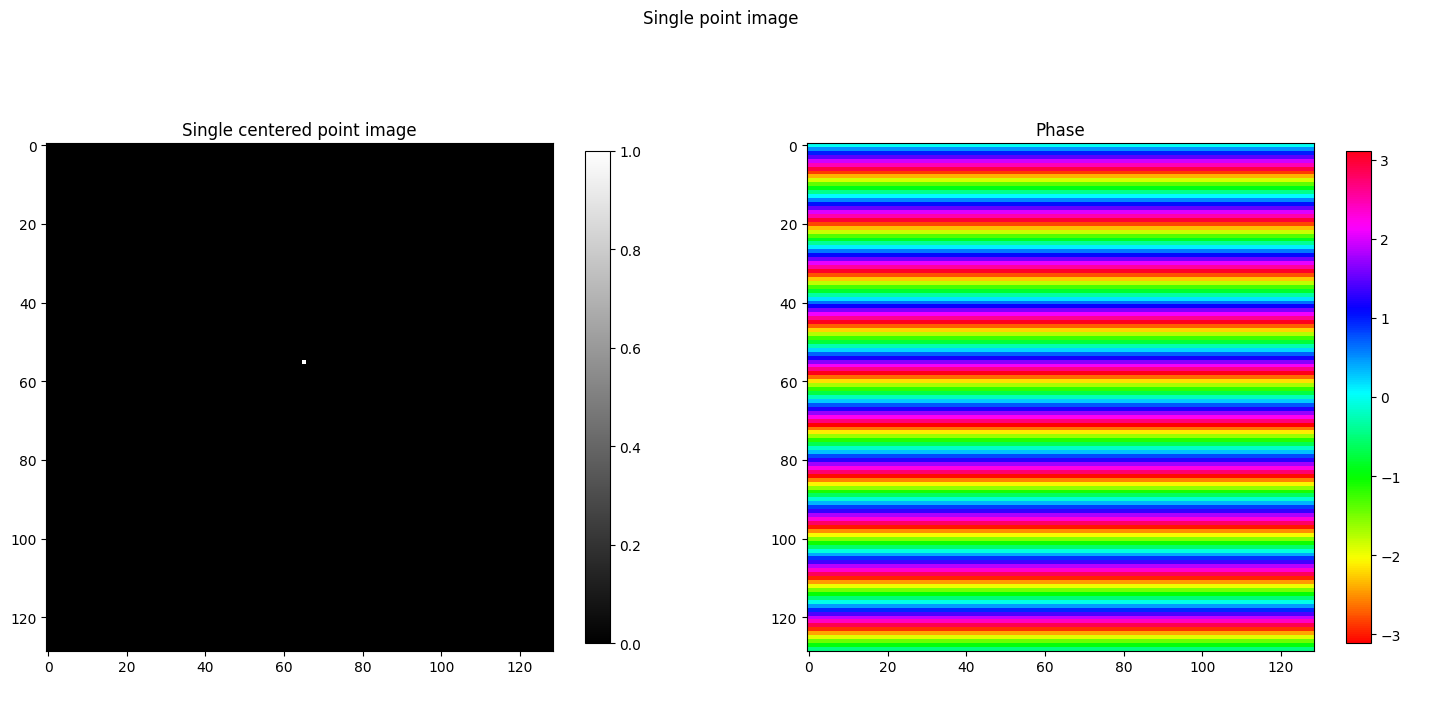
Remarks
- So moving the point to left side, we get fringe color pattern for the phase.
- Moving point vertically creates horizontal fringes.
- Moving point horizontally creates vertical fringes.
Phase fringe pattern while rotating pixel around center
def point_source_fft_circle(img_size, y_pos, x_pos, amp=1., radius=10.):
## create image
img = np.zeros((img_size + 1, img_size+2))
img[y_pos, x_pos] = amp
img_fft = np.fft.fft2(np.fft.fftshift(img))
## plot setup
plt.subplots(figsize=(18, 8))
plt.grid(False)
plt.axis(False)
## image plot without fft
ax = plt.subplot(1, 2, 1)
plt.set_cmap("gray")
plt.title("image without fft")
plt.imshow(img, interpolation='nearest')
plt.colorbar(shrink=0.8)
circle = plt.Circle(((img_size/2)+1, (img_size/2)+1), radius, color='blue', linewidth=2, fill=False)
ax.add_patch(circle)
## phase
phase = np.angle(img_fft)
plt.subplot(1, 2, 2)
plt.title("image phase")
plt.imshow(phase)
plt.set_cmap("hsv")
plt.colorbar(shrink=0.8)
img_size = 128
point_source_fft_circle(img_size, (img_size // 2) + 1 + 10, (img_size // 2) + 1)
point_source_fft_circle(img_size, (img_size // 2) + 1 + 10, (img_size // 2) + 1 + 10)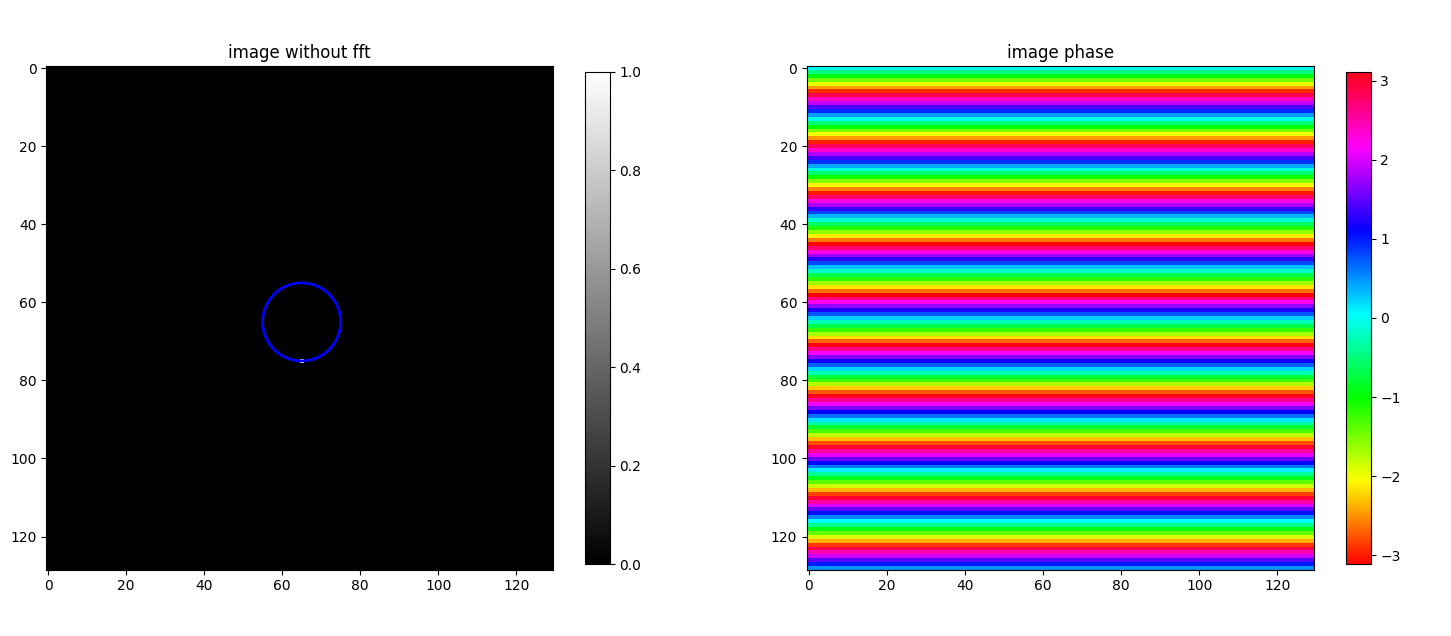
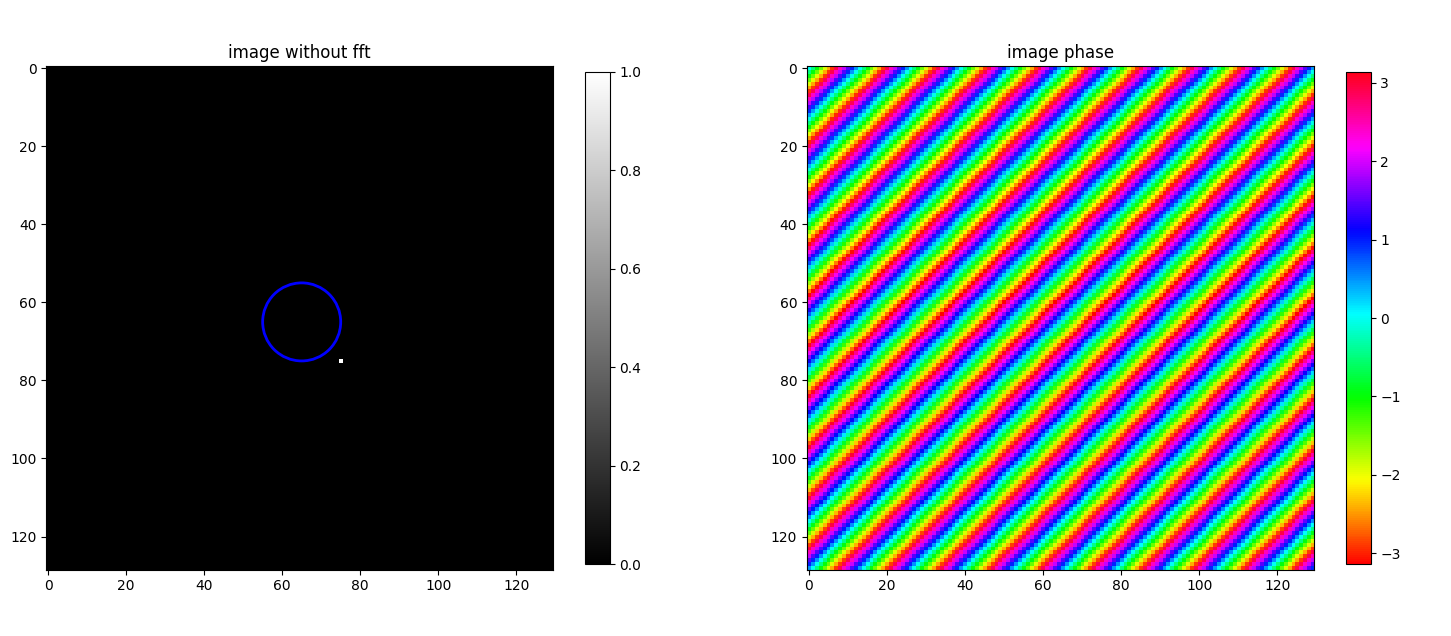
Remarks
- When the pixel position rotates around the center without changing the distance, the phase frequency remains the same but the phase rotates.
FFT of multiple source points
def multiple_fft(img_size, pos, amps):
img = np.zeros((img_size + 1, img_size + 1))
## fillup amps
for p, a in zip(pos, amps):
img[p[0], p[1]] = a
img_fft_phase = np.angle(np.fft.fft2(np.fft.fftshift(img)))
plt.subplots(figsize=(18, 8))
plt.suptitle("multiple source points image")
plt.grid(False)
plt.axis(False)
plt.subplot(1, 2, 1)
plt.title("image")
plt.imshow(img)
plt.set_cmap('gray')
plt.colorbar(shrink=0.8)
plt.subplot(1, 2, 2)
plt.title("phase")
plt.imshow(img_fft_phase)
plt.set_cmap("hsv")
plt.colorbar(shrink=0.8)
imgSize = 128
multiple_fft(imgSize, [[64, 65], [90,80]], [1., 1])
multiple_fft(imgSize, [[64,65], [90,80], [40,10], [60,50], [20,80]], [.2, 0.3, 0.5, 0.1, 0.7])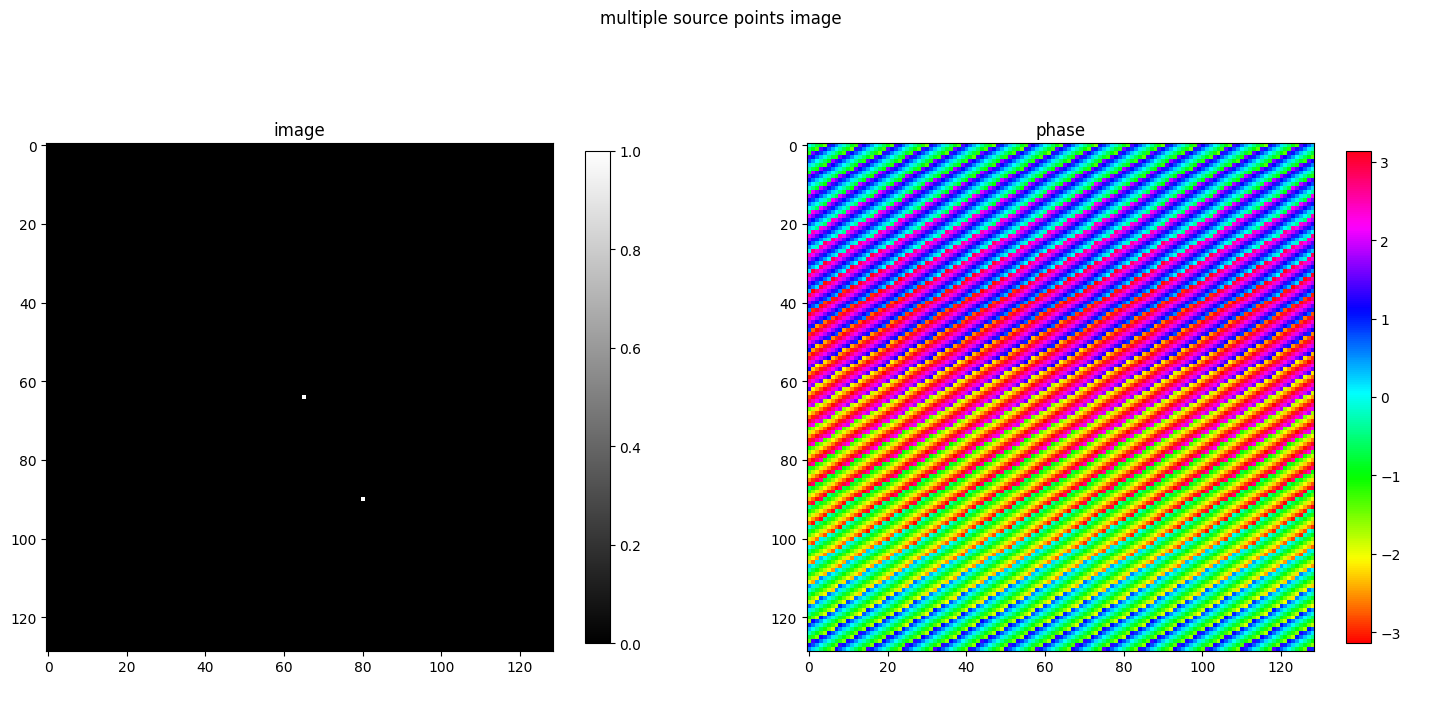
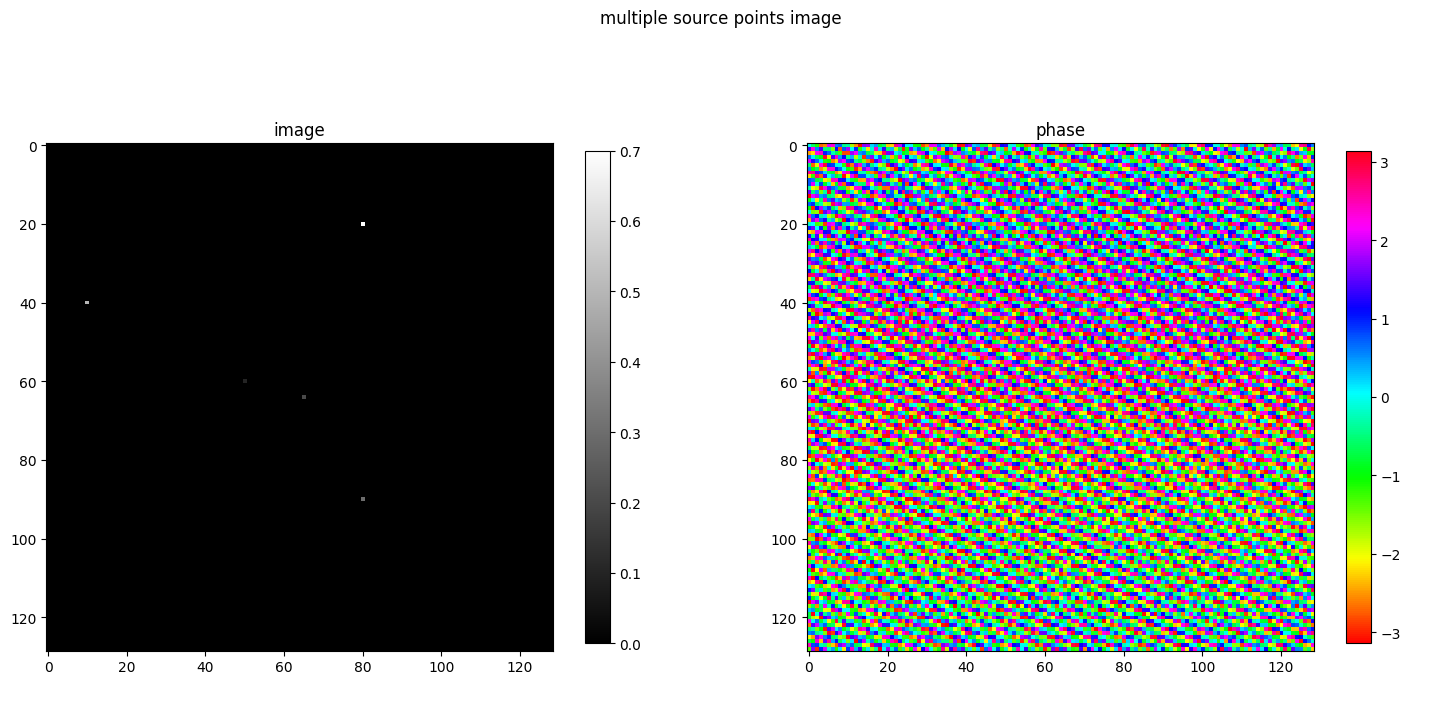
Remarks
- Image with multiple sources has resulting phase an amplitude weighted average of phases of each point source.
- It means that for the averaging of phases of each individual sources, their amplitudes are also taken into consideration.
Reconstructing duckk image
def reconstruct_image(vis, nsamples):
new_vis = np.zeros_like(vis)
y_pos = np.random.randint(0, high=vis.shape[0] - 1, size=int(nsamples))
x_pos = np.random.randint(0, high=vis.shape[1] - 1, size=int(nsamples))
new_vis[y_pos, x_pos] = vis[y_pos, x_pos] # substituting values
img = np.fft.ifft2(np.fft.fftshift(new_vis))
plt.subplots(figsize=(16, 6))
plt.suptitle("Image reconstruction by taking samples")
plt.grid(False)
plt.axis(False)
plt.subplot(1, 2, 1)
plt.imshow(np.abs(new_vis).astype(bool), interpolation='nearest', cmap="gray")
plt.title("sampled visibilities")
plt.subplot(1, 2, 2)
plt.imshow(np.abs(img), cmap="gray")
plt.title("Reconstructed image")reconstruct_image(duck_fft, 1e1)
reconstruct_image(duck_fft, 1e3)
reconstruct_image(duck_fft, 1e5)
reconstruct_image(duck_fft, 1e6)
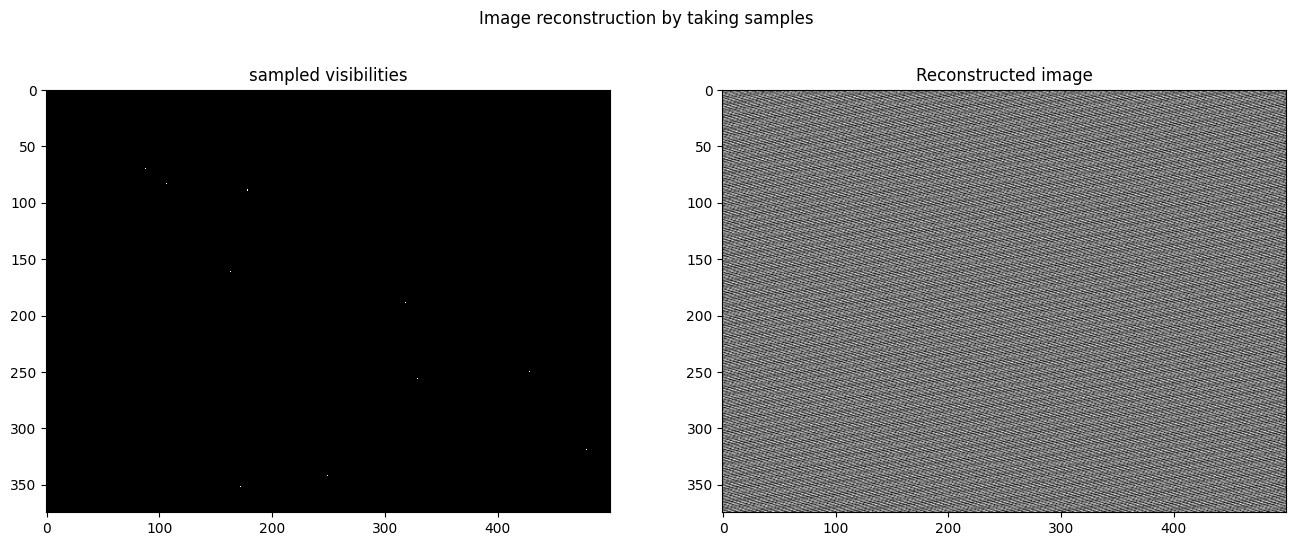
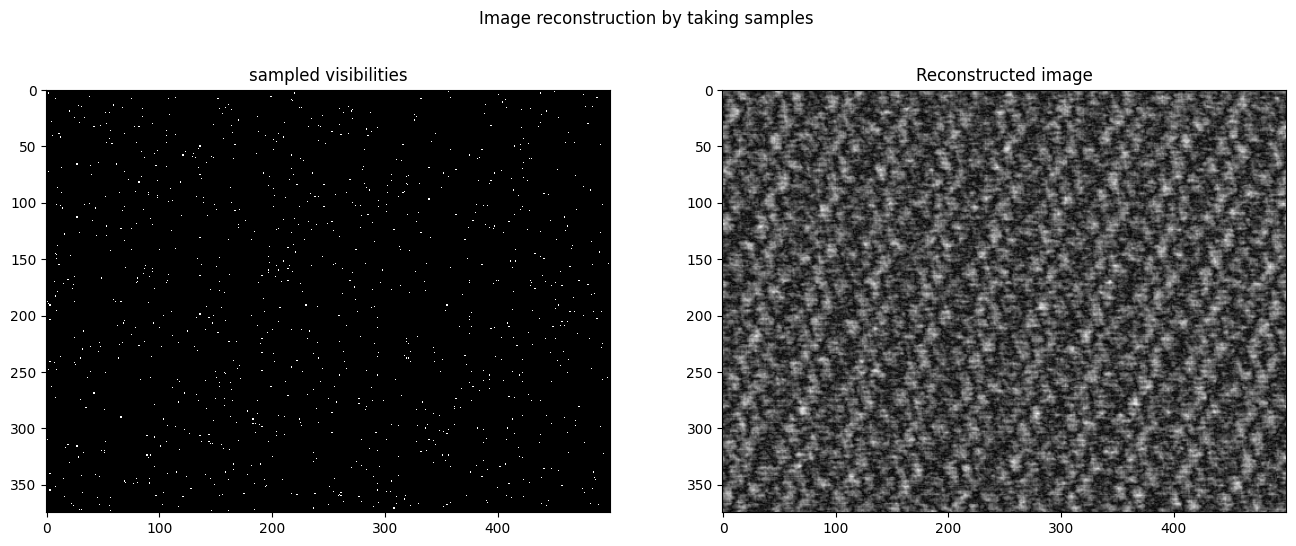
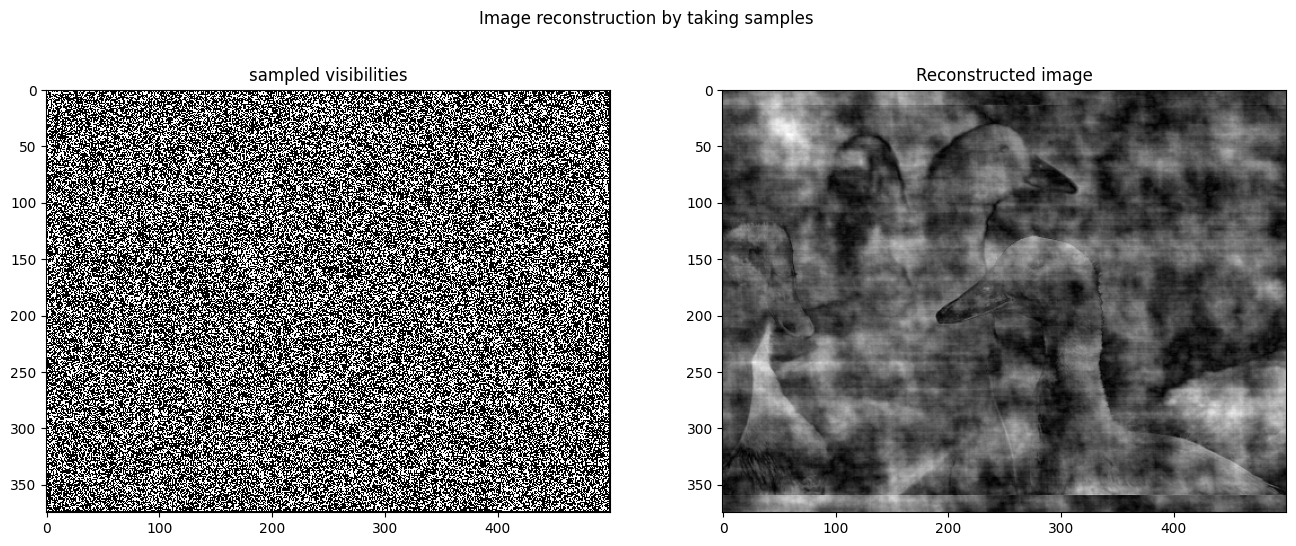
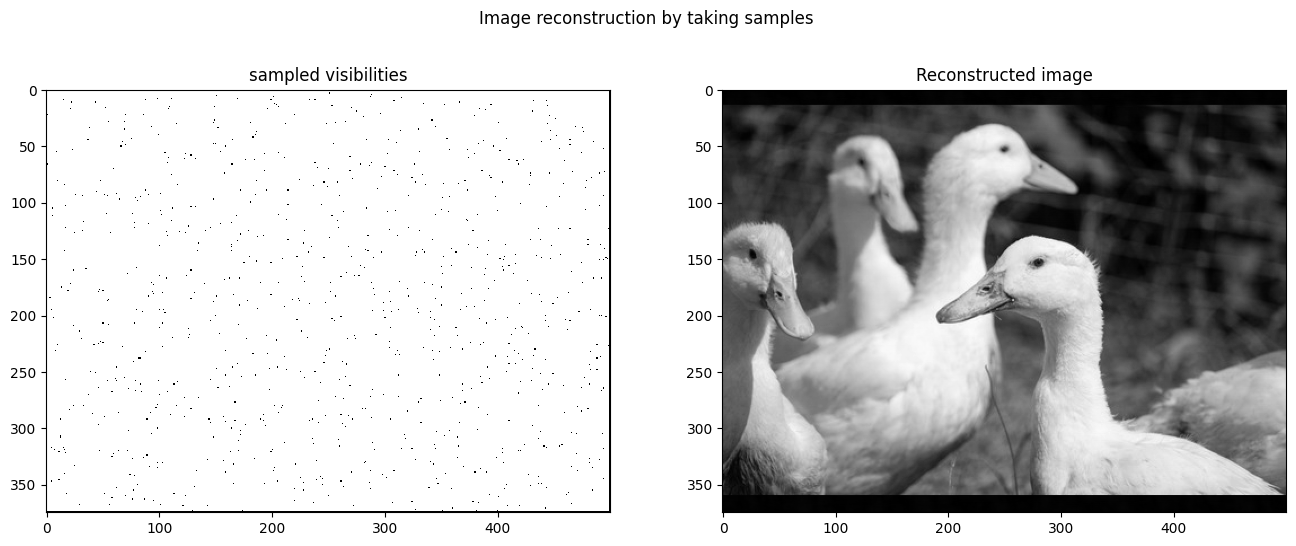
Remarks
- We can recreate the image by selecting spatial frequencies with different amplitude and phases.
- We don’t require to sample all the points to reconstruct the image.